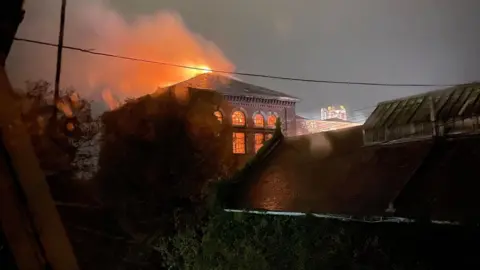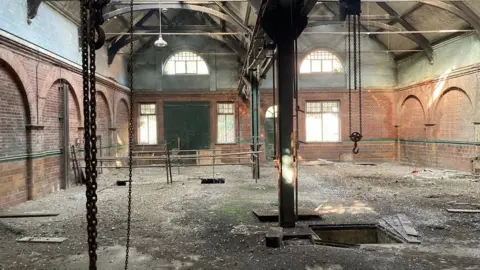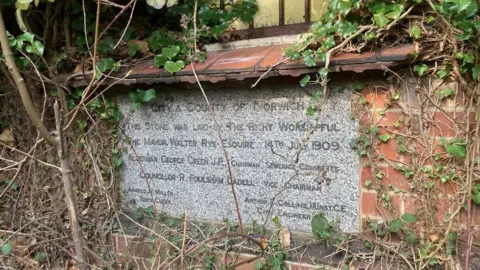Historians call for Trowse pumping station to be reutilised
 Roxy Wilkes
Roxy WilkesThe Victorian Society (VS) said it hoped fire damage to a "wonderful" historic pumping station would not prevent it getting a new lease of life.
The privately-owned Grade II-listed sewage treatment facility at Trowse in Norwich caught fire on Sunday night.
Norfolk Fire and Rescue Service said the cause of the blaze could not be ascertained due to its derelict state.
It is on VS's top 10 endangered buildings list of 2023. Owner Serruys has been contacted for comment.
Serruys bought the building in 2003 from the city council and it has stood mostly empty ever since.
 Sam Barker/@skyscout
Sam Barker/@skyscoutFollowing the fire, Connor McNeill from the VS said: "There's still a lot of damage to the roof, but it's still intact and the walls and the shell of the building are still there.
"We don't have a very clear idea of the damage done and it seems to have been restricted to one building on the site.
"It's a really wonderful building, but one that should have a new use."
By putting it on a protected list in 2021, the Victorian Society hoped this would encourage a developer to give the site a new lease of life.
"It's a really interesting building in the history of Norwich. In the 1850s, as with all British cities, there was a terrible problem with sewage, cholera and disease," said Mr McNeill.
The Great Stink of 1858 in London led to sewage works being built in the capital to treat human waste, prevent disease and curb smells from the River Thames.
 Sam Barker/@skyscout
Sam Barker/@skyscoutGeologist and historian Matt Williams, who lives in Norwich, said: "It wasn't until Norwich got a public water supply that Norwich really had a major problem of sewage in the river."
The invention of the water closet - or flushing toilet - was behind the river being polluted by raw human waste, he said.
Prior to flush toilets, human waste had been taken by night soil men on a cart to put on farmers' fields.
Mr Williams said the pumping station, completed in 1869, was a result of the city corporation being taken to court by people in Thorpe St Andrew, who were fed up with the River Yare next to their homes being full of human waste.
The geologist said Norwich being very low in the centre meant the sewage system was "challenging" to build.
"It's very difficult to build a sewer going downhill which is already at the water level, but they did it, and as a piece of engineering it was amazing," he said.
"By 1871, Norwich had a sewer taking the sewage out of the city and taking it downhill to Trowse, even though Trowse is pretty much the same height as Norwich."
 Sam Barker/@skyscout
Sam Barker/@skyscoutSteam operated beam engines at the Trowse pumping station forced debris from a sump, built five metres (17ft) below sea level, upwards and along a pipe to river outlets away from the city.
Trowse pumping station represented the best of Victorian industrial archaeology, said Mr Williams.
"It is old, it was very well built. Unfortunately the last few years it's degraded very badly."
A second pumping station at Trowse powered by electricity was constructed in 1909 to replace the original and is also listed.
Mr Williams hoped the station, with its mass of sewers leading to it, would be retained and utilised in some way.
"It all depends on what works for developers, but it is a very significant part of Norwich's history," he said.
The pumping station, on Bracondale, acquired listed status in December 2021 from Historic England.

Follow East of England news on Facebook, Instagram and X. Got a story? Email [email protected] or WhatsApp 0800 169 1830
